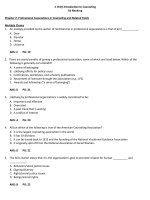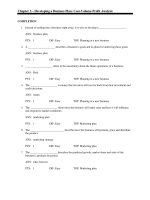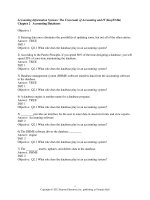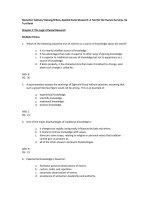Invitation to human communication 1st edition griffin test bank
Bạn đang xem bản rút gọn của tài liệu. Xem và tải ngay bản đầy đủ của tài liệu tại đây (117.42 KB, 2 trang )
Chapter 2: Communication, Perception, and the Self
MULTIPLE CHOICE
1. Perception consists of the social categories that we and others identify as important characteristics of
who we are.
A. True
B. False
ANS: B
PTS: 1
2. The factors that help determine which sensory data we will pay attention to include intensity and size,
repetition, contrast, and personal motivation.
A. True
B. False
ANS: A
PTS: 1
3. The perspectives from which a person views and evaluates society is called __________.
A. identity
B. standpoint
C. looking-glass self
D. self-concept
ANS: B
PTS: 1
4. Technology does not influence the process of perception.
A. True
B. False
ANS: B
PTS: 1
5. The speed at which tasks are accomplished is bound by cultural influences. While many cultures value
getting things done quickly, other cultures value taking time to relax and enjoy life at a slower pace.
A. True
B. False
ANS: A
PTS: 1
6. Andrea describes herself as a “heterosexual, female, Latina, and first generation college student.” This
description refers to Andrea’s __________.
A. standpoint
B. self-esteem
C. reflected appraisal
D. facework
ANS: A
PTS: 1
7. Jena’s parents often referred to her as the “shy child.” Jena internalized this label and continued to
avoid speaking during family gatherings and celebrations. The process of acting in accordance to the
labels bestowed on us is called __________.
A. facework
B. identity management
C. self-fulfilling prophecy
D. social comparison
ANS: C
PTS: 1
8. Some research suggests that initial opinions, or “first impressions,” are formed within as little as three
seconds of meeting someone.
A. True
B. False
ANS: A
PTS: 1
9. When we categorize people based on demographic characteristics such as age, sex, race, political or
religious affiliation, occupation, socio-economic backgrounds, or sexual orientation, we tend to rely on
stereotypes.
A. True
B. False
ANS: A
PTS: 1
10. Individuals who are acutely aware of their self-expressions and identity management behaviors are
called high self-monitors.
A. True
B. False
ANS: A
PTS: 1









